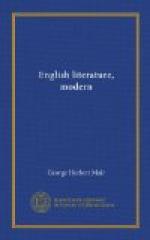His chief poetical works were most of them occasional—designed either to celebrate some remarkable event or to take a side and interpret a policy in the conflict, political or religious, of the time. Absalom and Achitophel and The Medal were levelled at the Shaftesbury-Monmouth intrigues in the closing years of Charles II. Religio Laici celebrated the excellence of the Church of England in its character of via media between the opposite extravagances of Papacy and Presbyterianism. The Hind and the Panther found this perfection spotted. The Church of England has become the Panther, whose coat is a varied pattern of heresy and truth beside the spotless purity of the Hind, the Church of Rome. Astrea Reddux welcomed the returning Charles; Annus Mirabilis commemorated a year of fire and victories, Besides these he wrote many dramas in verse, a number of translations, and some shorter poems, of which the odes are the most remarkable.
His qualities as a poet fitted very exactly the work he set himself to do. His work is always plain and easily understood; he had a fine faculty for narration, and the vigorous rapidity and point of his style enabled him to sketch a character or sum up a dialectical position very surely and effectively. His writing has a kind of spare and masculine force about it. It is this vigour and the impression which he gives of intellectual strength and of a logical grasp of his subject, that beyond question has kept alive work which, if ever poetry was, was ephemeral in its origin. The careers of the unscrupulous Caroline peers would have been closed for us were they not visible in the




